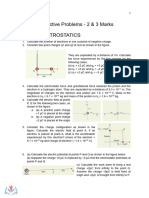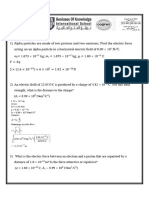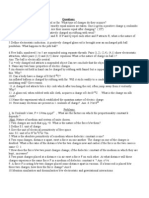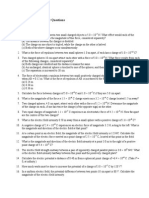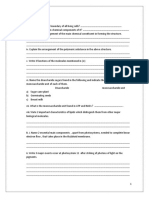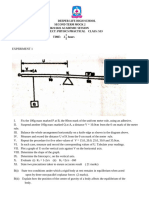Electric Field and Capacitors
Electric Field and Capacitors
Uploaded by
TharushiNethmiCopyright:
Available Formats
Electric Field and Capacitors
Electric Field and Capacitors
Uploaded by
TharushiNethmiOriginal Title
Copyright
Available Formats
Share this document
Did you find this document useful?
Is this content inappropriate?
Copyright:
Available Formats
Electric Field and Capacitors
Electric Field and Capacitors
Uploaded by
TharushiNethmiCopyright:
Available Formats
Electric field and capacitors
Electric charges
There are two types of charge: positive charge (carried by particles such as protons) and negative charge (carried
by particles such as electrons). The unit of charge is the coulomb (C). Experiments strongly suggest that charge
comes in discrete packets - i.e. it is quantised. The smallest unit of charge is 1.6 × 10-19C- the size of the charge on
an electron or proton - and all other amounts appear to come in integral multiples of this.
EX: Calculate the number of protons which would have a charge of one coulomb.(Proton charge = +1.6 × 10 -19 C.)
Electric fields
..................................................................................................................................................................................................
..................................................................................................................................................................................................
Representing electric fields
............................................................................................................................. ...........................................................................................
.................................................................................................................................................................... ....................................................
............................................................................................................................................................................................................ ............
....................................................................................................................... ...............................................................................................
Ex:Which of the three field diagrams in Figure
represents:
a two positive charges repelling each other?
b two negative charges?
c two opposite charges?
Electric field strength
The electric field strength at ..............................is defined as ...............................................acting on a
small ............................................................placed at that point.
stationary positive charge/ a point/ the force per unit charge
Susantha Hettiarchchi Page 1
Ex: Calculate the electric field strength at a point where a charge of 25 mC experiences a force vertically
downwards of 150 N.
Ex;An electric field strength at a point is 7000NC-1.Calculate the force acting on the following particles if they are
kept at the mention point.
a. 1C
b. 2C
c. An electron
d. Proton
e. An alpha particle
Uniform electric field strength
Ex1: The voltage between two parallel plates is 2.5V and the distance between them is 2cm.Calculte
a. The electric field between the plates
b. Force acting on an electron kept in between the plates
EX2: An electron is situated in a uniform electric field. The electric force that acts on it is 8 × 10-16 N. What is the
strength of the electric field?
Ex 3: What force will an electron feel when it is in the electric field of an X-ray machine which has a strength of
4.5 X 105 Vm-1 ?
Ex 4:An alpha particle enters the field between parallel plates 5mm apart; the bottom of which is held at 0V,while
the top plate is at 300V.Draw a diagram to show the path of the alpha particle through the plates and calculate
the force on the alpha particle.
Ex5: In Figure shown, two parallel plates are shown, separated by 25 cm.
a Draw field lines to represent the field between the plates.
b What is the potential difference between points A and B?
c What is the electric field strength at C, and at D?
d Calculate the electric force on a charge of +5μC placed at C. In which direction does the
force act?
Susantha Hettiarchchi Page 2
Ex 7: a. Calculate the vertical acceleration on an electron which enters parallel plates ,10cm long
,separated by 5mm with a P.D of 500V across them ,along the central horizontal axis.
b. Calculate how long it would take the electron to traverse the 2.5mm to the positive plate.
c. Show that if the electron enters the plates at 300ms-1, it will not emerge from the plates .but
will collide with the positive plate first.
(Me=9.11 x10-31kg ) Answer : 1.76 x 1016ms-2/5.3 x 10-10s
Equipotential lines
....................................................................................
....................................................................................
....................................................................................
....................................................................................
....................................................................................
....................................................................................
....................................................................................
....................................................................................
....................................................................................
....................................................................................
....................................................................................
The electron charge- Millikan’s experiment
...................................................................................................................
...................................................................................................................
...................................................................................................................
...................................................................................................................
...................................................................................................................
...................................................................................................................
..................................................................................................................
Susantha Hettiarchchi Page 3
Ex: A negatively charged polystyrene sphere of mass 3.3 × 10-15kg is held at rest between two
parallel plates separated by 5.0 mm when the potential difference between them is 170 V. How
many excess electrons are on the sphere?
Answer:6 electrons
Coulomb's Law
1. what is the force of attraction between a uranium nucleus (atomic number 92) and electron at a distance of
1x 10-12m.
2. Calculate the force between two point charges of +100µC placed 125cm apart in a vacuum. State what
difference it would make to the force calculated if one of the charges was negative.
Electric field and Point charges
A "point charge" - i.e. a body with charge, but no size - does not really exist, but it is a useful approximation for
small charged particles such as electrons.
Susantha Hettiarchchi Page 4
Equipotential lines around point charge
Ex1: What is the strength of the electric field caused by a gold nucleus (atomic number 79) at a distance of 1 x
10-12 m from the center of the nucleus?
Ex 2: What is the force of repulsion between an alpha particle and a gold nucleus when the alpha particle passes by
the nucleus at a distance of 1pm.
Ex3: Two charge particles of +8nC and-8nC are kept 6 cm away from each other .Calculate the electric field
strength of a point,
a. The center of two charges
b. 4cm from +8nC and 2cm away from -8nCcharge
c. If both the charges re +8nC what would be the electric field strength at the half way thought the charges
d. Calculate the electric field strength 4cm away from the midpoint
Ex4: In a simplified model of the hydrogen atom, the electron is at a distance of 5.3 × 10 −11m from the proton. The
proton charge is +1.6 × 10−19C. Calculate the electric field strength of the proton at this distance. Assuming that
the field is radial,
EX5: Two point charges of +2.4 µC and -2.9µC are placed at points A and B respectively in a vacuum. The distance
AB is 0.15 m, as shown in Figure. It is required to find a point P at which the resultant electric field due to these
two charges is zero. Deduce the point p.
Ex6: Calculate the electric field strenth t X due to the chrges shown in the following figure.
Susantha Hettiarchchi Page 5
Graph E against Distance (Radial and uniform)
1. The diagram shows a simplified version of the apparatus used in an experiment to determine
the charge on an electron.
Negatively charged oil drops are sprayed into a region above two parallel metal plates.
The plates are separated by a distance d. The oil drops are allowed to enter the region
between the two plates.
A potential difference V is applied which causes an electric field to be set up between the plates.
a. The diagram shows one oil drop falling between the plates.
Add lines to the diagram to show the electric field between the plates.
b. V is gradually increased. At a particular value of V, the oil drop stops falling and remains stationary between
the plates. Explain this observation.
c. The oil drop has mass m and charge Q and stops falling when V = 5000 V. Show that Q/m for this oil drop is
about 50 μC kg-1
d = 2.5 cm
d. The oil drop is close to another oil drop that has the same charge and mass. The oil drops can be considered to
act as point charges 2.2 mm apart. Calculate the electrostatic force between the two drops. mass of each drop
= 1.0 × 10−13 kg
(2016 AL)
Susantha Hettiarchchi Page 6
2.
a) Coulomb’s law for the force F between point charges Q1 and Q2, which are a distance r apart, is
given by
Express the unit of ε0 in base units.
b) Electric fields are caused by both point charges and by parallel plates with a potential
difference across them. Describe the difference between the electric field caused by a point
charge and the electric field between parallel plates. Your answer should include a diagram of each
type of field and reference to electric field strength.
(5)
c) Two small spheres L and M are attached to non-conducting threads and suspended
from a point P. Each sphere is given an equal positive charge of 4.0 × 10–7 C. The
spheres hang in equilibrium as shown in the diagram.
The mass of each sphere is 2.7 g.
By considering the forces acting on one of the spheres, calculate the tension in the
thread and the angle θ.
2015 June
Susantha Hettiarchchi Page 7
Electric potential and Electric potential energy
What is electrical potential ?
Electric potential is defined as the potential energy per unit positive charge. The symbol for
potential is V, and its unit is the volt. If a point charge Q has potential energy EPA at a
point A, the electric potential at that point is ,
VA = EPA/Q
Only differences in potential energy are measurable. We need to specify a convenient reference point to
act as a zero of potential energy and potential. In dealing with gravitational energy we often take the
floor of the laboratory or the Earth’s surface as zero, and measure mgh from one of these. Similarly, in
electrical problems, it is often convenient to take earth potential as zero, especially if part of
the circuit is earthed. But the ‘official’ definition of the zero of electric potential is the potential of a
point an infinite distance away. This means that
The electrical potential at a point in an electric field is defined as the work done per
unit positive charge in bringing a small test charge from infinity to the point.
Energy and potential in a radial field
Susantha Hettiarchchi Page 8
EX:Calcualte the electrical potentoal 0.4m away from a charge of Q of +30C.Then calculate the amount
of work must be done in order to bring a charge of +2C of charge to the point mention.
1.4 J
Ex;A charge of Q of 40C is kept in a vaccume.
a. A point A is 0.3cm away from the charge Q ,calculate the Potental at 0.3cm away from
the charge Q
b. A point B is 0.5cm away from the charge Q ,calculate the potental at 0.5cm away from
the charge Q
c. Calculate the amount of work has to be done in oder to move an electron from point B
to A
Ex. Two point charges A and B each have a charge of +6.4 × 10−19C. They are separated in a vacuum by a
distance of 12.0µm, as shown in Fig.
Points P and Q are situated on the line AB.Point P is 3.0µm from charge A and point
Q is 3.0µm from charge B.
a Calculate the force of repulsion between the charges A and B. [3]
b Explain why, without any calculation,when a small test charge is moved from point P to point Q, the net
work done is zero. [2]
c Calculate the work done by an electron in moving from
the midpoint of line AB to point P. [4]
Susantha Hettiarchchi Page 9
Capacitors
A capacitor is simply two pieces of metal near each other,
separated by an insulator or air. A capacitor is used to store charge
and energy.
Although a capacitor can be made from any two conductors close
to each other, we have considered the simplest case where the
The symbol for a capacitor is simply:
conductors are two parallel metal plates. You should also note that
The symbol for a capacitor is simply: the plates are separated by an insulator, in this case air. The
insulating material is called the dielectric. Because the dielectric is
an insulator it is clear that a steady d.c. current cannot pass through
a capacitor and this is why we only get the brief pulse of charge
referred to above.
How Does a Capacitor Work ?
When two conducting plates are connected to a
battery electrons move towards one plate. The
positive plate loses electrons as well,
eventually leave both plates with equal and
opposite charge, +Q and -Q. When a capacitor is
charged (i.e. electrons are ‘no longer’ moving) we
say that the capacitor has charge Q (even
though the overall charge is zero).
The charges make an E-field, which means a voltage difference between the plates. The "voltage V on a
capacitor" always means the voltage difference V between the plates.
Susantha Hettiarchchi Page 10
The relationship between voltage and charge of a capacitor(Capacitance)
Measure the charge stored in the capacitor for various potential differences ,
Combining capacitors in parallel and series
Remember: for capacitors in parallel, the potential difference across each capacitor is the same.
Remember: for capacitors in series, the charge on each capacitor must be the same and the applied
potential is divided.
Susantha Hettiarchchi Page 11
Energy stored in a capacitor
1. Calculate the charge on a 220µF capacitor charged up to 15 V. Give your answer in micro coulombs
(µC) and in coulombs (C).
2. A charge of 1.0 × 10−3 C is measured on a capacitor with a potential difference across it of 500 V.
Calculate the capacitance in farads (F), microfarads (µF) and Pico farads (pF).
3. Calculate the average current required to charge a 50µF capacitor to a p.d. of 10 V in a time
interval of 0.01 s.
4. A 2000µF capacitor is charged to a p.d. of 10 V. Calculate the energy stored by the capacitor
5. Calculate the energy stored in the following capacitors:
a a 5000µF capacitor charged to 5.0 V
b a 5000 pF capacitor charged to 5.0 V
c a 200µF capacitor charged to 230 V.
6. Which involves more charge, a 100µF capacitor charged to 200 V or a 200µF capacitor charged to
100 V? Which stores more energy?
7. A 10 000µF capacitor is charged to 12 V, and then connected across a lamp rated at ‘12 V, 36 W’.
a Calculate the energy stored by the capacitor.
b Estimate the time the lamp stays fully lit.
Assume that energy is dissipated in the lamp at a steady rate.
8. In a simple photographic flashgun, a 0.20 F capacitor is charged by a 9.0 V battery. It is then
discharged in a flash of duration 0.01 s. Calculate:
a the charge on and energy stored by the capacitor
b the average power dissipated during the flash
c the average current in the flash bulb
d the approximate resistance of the bulb.
Two capacitors of 5µF and 2µF are connected in parallel and a d.c. supply of 50 volts applied to the
combination. Calculate:
(i) the charge on each,
(ii) the total charge stored,
(iii) the total capacitance of the combination,
(iv) the charge stored on the combination
Two capacitors of 16µF and 48µF are on connected in series and a d.c. supply of 40 volts applied to the
combination.
Calculate
(i) the total capacitance
(ii) the total charge stored
(iii) the charge on each capacitor
(iv) the potential difference across each capacitor.
A 10µF capacitor, initially uncharged, is connected to a 2 volt
supply. Calculate
Susantha Hettiarchchi Page 12
(i) the charge transferred from the supply to the capacitor
(ii) the energy taken from the supply
(iii) the energy stored in the capacitor.
Charging and discharging
Charging curves
............................................................................................................................
............................................................................................................................
............................................................................................................................
Discharging curves
Charge reaming in the capacitor and time
Susantha Hettiarchchi Page 13
When capacitor is discharge, The remaining charge in the capacitor is decreased exponentially.The remaining
charge in the capacitor is given by
Where
Q =...........................................Q0=..............................................................
T=................................................R=............................................................
C =.......................................................................................................................
EX: Calculate the initial charge of the capacitor given above
Calculate the charge remaining in the capacitor after 2ms and 4ms by using the equation
Use the graph given to confirm your answers
Time constant –RC
Derived the base unit of RC
.................................................................................................................
.................................................................................................................
.................................................................................................................
.................................................................................................................
.................................................................................................................
.................................................................................................................
.................................................................................................................
.................................................................................................................
Calculate the time constant of the capacitor given above
Calculate the charge remaining in the capacitor after RC time
Susantha Hettiarchchi Page 14
Half life
If you want to find the time taken for the remaining charge in the capacitor to be half of the initial
charge,
Calculate the half time of capacitor given above by the equation and check with the graph
Discharging curves –voltage across the capacitor Vs time
Susantha Hettiarchchi Page 15
Ex:In recent years there has been a development of ultracapacitors which have much higher capacitance than
traditional capacitors. Capacitors store energy due to charge in an electric field whereas batteries store energy
due to a chemical reaction. There are several applications where ultracapacitors have an advantage over batteries;
for example storing energy from rapidly fluctuating supplies or delivering charge very quickly
I. A typical ultracapacitor has a capacitance of 1500 F and a maximum operating potential difference of 2.6 V.
Show that the charge on this capacitor when fully charged is about 4000 C.
II. Complete the graph on the axes below to show how the potential difference varies with charge for this
capacitor.
III. The graph below shows how the current varies with time as the capacitor is discharged through a circuit.
IV. Calculate the resistance of the circuit.
1st method
2nd method
3rd method
Susantha Hettiarchchi Page 16
R = 0.00050 Ω – 0.00058 Ω
Ex:
Calculate the charge on C1 60 seconds after closing S
1. Some lights are designed to dim gradually after being switched off. This can be done
using a capacitor in a timer circuit. The circuit diagram shows how a potential difference (p.d.) can be
supplied across a resistor for a limited time.
(a) When the switch is at position A, the capacitor charges.
(i) In terms of the movement of electrons, explain what happens to the capacitor as it
becomes fully charged.
(ii) Calculate the energy stored in the charged capacitor.
(b) The switch is moved to position B and the capacitor discharges through the resistor.
(i) Describe what happens to the current through the resistor.
(ii) For the circuit shown ,the p.d across the capacitor falls to 10% of the supply p.d after 25 s.
Calculate the resistance of the resistor in the circuit.
2016 Jan(IAL)
2. A student is investigating capacitance. She sets up the circuit shown.
(a) When the switch is closed there is a maximum current, which decreases to zero over
a period of time as the capacitor charges. Explain why.
(b) The student discharged the capacitor. She set the variable resistor to its maximum
resistance and closed the switch. As the capacitor charged, the student decreased
the resistance of the variable resistor so that the current remained constant until the
Susantha Hettiarchchi Page 17
capacitor was fully charged.
A graph of current against time is shown.
(i) Determine the capacitance of the capacitor.
(ii) Hence determine the energy stored by the capacitor when it is fully charged.
(c) Capacitance can also be determined by measuring the current I at regular time
intervals, as a capacitor discharges through a resistor, and plotting a graph of ln I
against time.
(i) Explain how capacitance can be determined using this graph.
(ii) A capacitor was discharged through a 390 Ω resistor. The capacitance of the
capacitor was calculated as 2200 µF.
Explain why the data for the graph for this circuit would be difficult to obtain
using an ammeter. Your answer should include a calculation.
2016 June(IAL)
Susantha Hettiarchchi Page 18
You might also like
- Abc of Capacitors: Basic PrinciplesFrom EverandAbc of Capacitors: Basic PrinciplesWürth ElektronikNo ratings yet
- 4.3 Electric Fields PDFDocument10 pages4.3 Electric Fields PDFAssis GomesNo ratings yet
- Chapter 24 - Electric PotentialDocument12 pagesChapter 24 - Electric PotentialVV CepheiNo ratings yet
- Module 6: Electromagnetism Topic 1.1: Charged Particles in Electric/Magnetic FieldsDocument13 pagesModule 6: Electromagnetism Topic 1.1: Charged Particles in Electric/Magnetic FieldsReacher ElliotNo ratings yet
- Q3 Mod 1Document20 pagesQ3 Mod 1Gladys MartinezNo ratings yet
- Two Three Mark ProblemsDocument14 pagesTwo Three Mark Problemssrirampratap2401No ratings yet
- Chapter 15 ProblemsDocument7 pagesChapter 15 Problemsekojanti100% (2)
- Applied PhysicsDocument5 pagesApplied Physicsahmad irtisamNo ratings yet
- P QuestionDocument4 pagesP QuestionbabariyapruthviNo ratings yet
- Assignment Summer VacationsDocument3 pagesAssignment Summer VacationsGunveer SinghNo ratings yet
- Electrostatics Questions Energy and Work With AnswersDocument14 pagesElectrostatics Questions Energy and Work With Answersmicheal_cksNo ratings yet
- Worksheet 2 Electric Charges and Field (Numerical and Conceptual)Document6 pagesWorksheet 2 Electric Charges and Field (Numerical and Conceptual)jeeaspirant2025sNo ratings yet
- W 4 BookDocument55 pagesW 4 BookAdri De Udok100% (1)
- 1.electrico Statics WorksheetDocument3 pages1.electrico Statics WorksheetAdithyaNo ratings yet
- ElectrostaticsDocument47 pagesElectrostaticsKaran JeetNo ratings yet
- 39F111CFDocument7 pages39F111CFJudi El AzhariNo ratings yet
- Numerical On ElectrostaticsDocument2 pagesNumerical On ElectrostaticsAshok Pradhan0% (1)
- Unit - 4 Work SheetDocument6 pagesUnit - 4 Work SheetNathan GetachewNo ratings yet
- 33gel Elektromagnetik PDFDocument20 pages33gel Elektromagnetik PDFAsepta Surya WardhanaNo ratings yet
- Class 12 Physics Summer Vacations Holiday Homework 2024-25Document4 pagesClass 12 Physics Summer Vacations Holiday Homework 2024-25abhishek990ajsvvNo ratings yet
- Coulomb's Law - QuestionsDocument4 pagesCoulomb's Law - QuestionsAhamad FalahNo ratings yet
- Answers ofAQP PhysicsDocument17 pagesAnswers ofAQP PhysicsApSWgxmwNo ratings yet
- AP - IB Review Guide CH15Document5 pagesAP - IB Review Guide CH15Muhammad SyarifudinNo ratings yet
- Important ProblemsDocument2 pagesImportant ProblemsGanesh MogaveeraNo ratings yet
- Electric Fields and Magnetism - Practice TestDocument5 pagesElectric Fields and Magnetism - Practice Testharkeerat singhNo ratings yet
- Electrostatic Forces, Charges and FieldsDocument9 pagesElectrostatic Forces, Charges and FieldsDeepak PachauriNo ratings yet
- NEW Electricity and Circuits GuideDocument33 pagesNEW Electricity and Circuits Guidebezoz420No ratings yet
- Numerical On ElectrostaticsDocument2 pagesNumerical On ElectrostaticsAshok Pradhan0% (1)
- Illustrations: (Int: Cos)Document3 pagesIllustrations: (Int: Cos)LODHKA RAVINo ratings yet
- 14 TestrDocument5 pages14 TestrΧρίστος ΠαπαναστασίουNo ratings yet
- Phy Worksheet CH 1 2024Document5 pagesPhy Worksheet CH 1 2024siva prakasamNo ratings yet
- Fields - QP IBDP PhysicsDocument9 pagesFields - QP IBDP PhysicsArham ShahNo ratings yet
- QuestionsDocument5 pagesQuestionsHarshin MohanNo ratings yet
- Physics Homework #131 Electrostatics Electric Fields: © J. Kovalcin 2000Document10 pagesPhysics Homework #131 Electrostatics Electric Fields: © J. Kovalcin 2000Joshua CooperNo ratings yet
- Physics 2013 Set 1Document28 pagesPhysics 2013 Set 1sethiaashishNo ratings yet
- 12 Physics 1Document87 pages12 Physics 1SNo ratings yet
- Tamil Nadu Board Question Paper For Class 12 Physics 2015Document24 pagesTamil Nadu Board Question Paper For Class 12 Physics 2015eniyan rNo ratings yet
- All Electricity Worksheets For Midterm 22Document22 pagesAll Electricity Worksheets For Midterm 22Maryam AlkaabiNo ratings yet
- Electromagnetism Session 2 QuestionsDocument80 pagesElectromagnetism Session 2 QuestionsJohn English100% (1)
- ไฟฟ้า EPDocument9 pagesไฟฟ้า EPSucheela LairaksaNo ratings yet
- Ch. 15&16 - Electrostatics Problem Set PDFDocument4 pagesCh. 15&16 - Electrostatics Problem Set PDFNico RodriguezNo ratings yet
- Tugas Fisika IntiDocument35 pagesTugas Fisika IntiSharasanty PNo ratings yet
- Physics XII: Important Questions 2020 NumericalDocument3 pagesPhysics XII: Important Questions 2020 NumericalShaheer JafriNo ratings yet
- CPP ElectrostiaticsDocument6 pagesCPP Electrostiaticsdhvdcqcrv6No ratings yet
- Parallel PlatesDocument10 pagesParallel PlatesJohn JohnsonNo ratings yet
- Electrostatic Practice W Answers FixedDocument1 pageElectrostatic Practice W Answers Fixedvictorymornah017No ratings yet
- Physics: Ideas To Implementation PPDocument129 pagesPhysics: Ideas To Implementation PPBam BooNo ratings yet
- Electric Charges and Field: Very Short Answer Type QuestionsDocument4 pagesElectric Charges and Field: Very Short Answer Type QuestionsAvni Raghav100% (1)
- Numerical Problems-1Document2 pagesNumerical Problems-1Hur ZaheerNo ratings yet
- Phy 1 - 2022Document30 pagesPhy 1 - 2022sangoi_vipulNo ratings yet
- 2011 GR 12 Phy Electrostatics-1Document2 pages2011 GR 12 Phy Electrostatics-1Tania LizNo ratings yet
- Assignmnet 1 APPLIED PHYSICSDocument2 pagesAssignmnet 1 APPLIED PHYSICSNa Nu SorryNo ratings yet
- Question Bank - ElectromagnetismDocument6 pagesQuestion Bank - ElectromagnetismDaksh SoumyaNo ratings yet
- Chapter 5: Electric Charges and FieldsDocument7 pagesChapter 5: Electric Charges and FieldsNATASHA MARCELA DAVIDNo ratings yet
- ElectrostaticDocument2 pagesElectrostaticAlyssa ColeNo ratings yet
- Electrostatic ForceDocument3 pagesElectrostatic ForceAlyssa Cole100% (1)
- LabInABox EOverMDocument8 pagesLabInABox EOverMaynniquratulainNo ratings yet
- O level Physics Questions And Answer Practice Papers 2From EverandO level Physics Questions And Answer Practice Papers 2Rating: 5 out of 5 stars5/5 (1)
- O level Physics Questions And Answer Practice Papers 1From EverandO level Physics Questions And Answer Practice Papers 1Rating: 3.5 out of 5 stars3.5/5 (4)
- 2015 Physics Bahuwarana WiwaranayaDocument7 pages2015 Physics Bahuwarana WiwaranayaTharushiNethmi0% (1)
- Sri Lanka Examinations Prices JUNE 2018Document17 pagesSri Lanka Examinations Prices JUNE 2018TharushiNethmiNo ratings yet
- 2019 Prototype PapersDocument212 pages2019 Prototype PapersTharushiNethmiNo ratings yet
- Aadhila Nasir-800: Random Essay Question - 20Document1 pageAadhila Nasir-800: Random Essay Question - 20TharushiNethmiNo ratings yet
- Magnetism For Physics Grade 12Document15 pagesMagnetism For Physics Grade 12TharushiNethmiNo ratings yet
- Aadhila Nasir-800: Random Essay Question - 20Document1 pageAadhila Nasir-800: Random Essay Question - 20TharushiNethmiNo ratings yet
- 2017 AL Chemistry Past Paper - English MediumDocument23 pages2017 AL Chemistry Past Paper - English MediumTharushiNethmiNo ratings yet
- 2017 AL Chemistry Past Paper - English MediumDocument23 pages2017 AL Chemistry Past Paper - English MediumTharushiNethmiNo ratings yet
- Aadhila Nasir-800: Random Essay Question - 20Document1 pageAadhila Nasir-800: Random Essay Question - 20TharushiNethmiNo ratings yet
- Assignment No: 07Document4 pagesAssignment No: 07TharushiNethmiNo ratings yet
- CamScanner 09-25-2020 16.18.31Document24 pagesCamScanner 09-25-2020 16.18.31TharushiNethmiNo ratings yet
- Gene Mutations-Essay 69Document2 pagesGene Mutations-Essay 69TharushiNethmiNo ratings yet
- Past Paper Questions: PhysicsDocument32 pagesPast Paper Questions: PhysicsTharushiNethmiNo ratings yet
- 2021-Paper 66Document11 pages2021-Paper 66TharushiNethmiNo ratings yet
- CamScanner 01-06-2021 12.31Document28 pagesCamScanner 01-06-2021 12.31TharushiNethmiNo ratings yet
- L 2021 Model Paper - 45Document10 pagesL 2021 Model Paper - 45TharushiNethmi100% (1)
- 2021 - Paper 68.Document14 pages2021 - Paper 68.TharushiNethmiNo ratings yet
- EGr13OM Physical Chemistry-Part 2Document279 pagesEGr13OM Physical Chemistry-Part 2TharushiNethmiNo ratings yet
- EGr12TG PhysicsDocument72 pagesEGr12TG PhysicsTharushiNethmiNo ratings yet
- OsiSense XS XS2M12KP340 DocumentDocument6 pagesOsiSense XS XS2M12KP340 Documentabdelhadi houssinNo ratings yet
- Week 2 Day 2 Module Physical ScienceDocument3 pagesWeek 2 Day 2 Module Physical ScienceEunice AcunaNo ratings yet
- Dhruv Bhardwaj Physics 11 Law of Motion ProjectDocument30 pagesDhruv Bhardwaj Physics 11 Law of Motion ProjectComrade YT0% (2)
- Cat - Dcs.sis - Controller Cs-663e AefDocument2 pagesCat - Dcs.sis - Controller Cs-663e AefLhsan Rajawi0% (1)
- Science: Quarter 3 - Module 5 Your Light Is My Life!Document38 pagesScience: Quarter 3 - Module 5 Your Light Is My Life!Queenie AlejandroNo ratings yet
- Software Lab ManualDocument74 pagesSoftware Lab Manualj.o.h.n.d20082004No ratings yet
- BCL-TA - (2 - 8a) - TECH - Manual - ENG - (DBQ100-EN Rev00) PDFDocument63 pagesBCL-TA - (2 - 8a) - TECH - Manual - ENG - (DBQ100-EN Rev00) PDFGhozy AnamNo ratings yet
- 15 - Electric Circuits - ExerciseDocument12 pages15 - Electric Circuits - Exercisekenchan0810.kcNo ratings yet
- COOLINGDocument17 pagesCOOLINGViki PrasadNo ratings yet
- Physics Test 7Document12 pagesPhysics Test 7RaphaelNo ratings yet
- Part VIDocument22 pagesPart VIRonak RanaNo ratings yet
- Week 1 - AssignmentDocument5 pagesWeek 1 - AssignmentSourabh BARIKNo ratings yet
- Unit Four Electrostatics 2Document5 pagesUnit Four Electrostatics 2Desta LelagoNo ratings yet
- GR 12 Physics Notes Alternating CurrentDocument10 pagesGR 12 Physics Notes Alternating Current16739No ratings yet
- Nxplus C: Technical DescriptionDocument37 pagesNxplus C: Technical DescriptionFeodor RadilovNo ratings yet
- The Effect of Using Minimum and Maximum Utility Fault Contributions On Arc Flash Study Results - A Case StudyDocument5 pagesThe Effect of Using Minimum and Maximum Utility Fault Contributions On Arc Flash Study Results - A Case StudyPaulo H TavaresNo ratings yet
- Power CablesDocument8 pagesPower Cableslam2660% (1)
- SS 3 Physis Mok 2 PraticalDocument6 pagesSS 3 Physis Mok 2 PraticalanyakahcNo ratings yet
- Class-XII Sub-Physics Date-28-10-2020 NameDocument3 pagesClass-XII Sub-Physics Date-28-10-2020 NameLORD X GAMERNo ratings yet
- 3101 Physics Paper+With+Ans EveningDocument4 pages3101 Physics Paper+With+Ans EveningPRITAM KumarNo ratings yet
- Voltage Source Inverter (VSI) ControlDocument34 pagesVoltage Source Inverter (VSI) ControlPrem SagarNo ratings yet
- Lab Report in Electrical MachinesDocument13 pagesLab Report in Electrical MachinesJohn Lloyd ComiaNo ratings yet
- s9014 FM Transmitter ThesisDocument5 pagess9014 FM Transmitter ThesisAyaz Ahmad100% (2)
- Essay On EM SpectrumDocument2 pagesEssay On EM SpectrumMely Rose MedranoNo ratings yet
- Sample Paper 2Document9 pagesSample Paper 2nivedita guptaNo ratings yet
- Basic Electricity Continuing Education Professional Development CourseDocument297 pagesBasic Electricity Continuing Education Professional Development CourseKanimozhivendhan Vendhan100% (1)
- John M. Kolyer, Donald E. Watson (Auth.) - ESD From A To Z - Electrostatic Discharge Control For Electronics-Springer US (1996)Document345 pagesJohn M. Kolyer, Donald E. Watson (Auth.) - ESD From A To Z - Electrostatic Discharge Control For Electronics-Springer US (1996)Ari HaranNo ratings yet
- Acoustic Waves and Tools: Baker Atlas Montrose Training CentreDocument34 pagesAcoustic Waves and Tools: Baker Atlas Montrose Training Centremohamed elshemyNo ratings yet
- WISEM-2020-21 PHY1701 ETH VL2020211000264 Reference Material II 10-Nov-2020 Schroendinger Time Dependent and Independent Wave EquationsDocument11 pagesWISEM-2020-21 PHY1701 ETH VL2020211000264 Reference Material II 10-Nov-2020 Schroendinger Time Dependent and Independent Wave EquationsShivam Kumar Singh 18BME0066No ratings yet
- Magnetostatic FieldsDocument31 pagesMagnetostatic FieldsAklilu AyeleNo ratings yet





